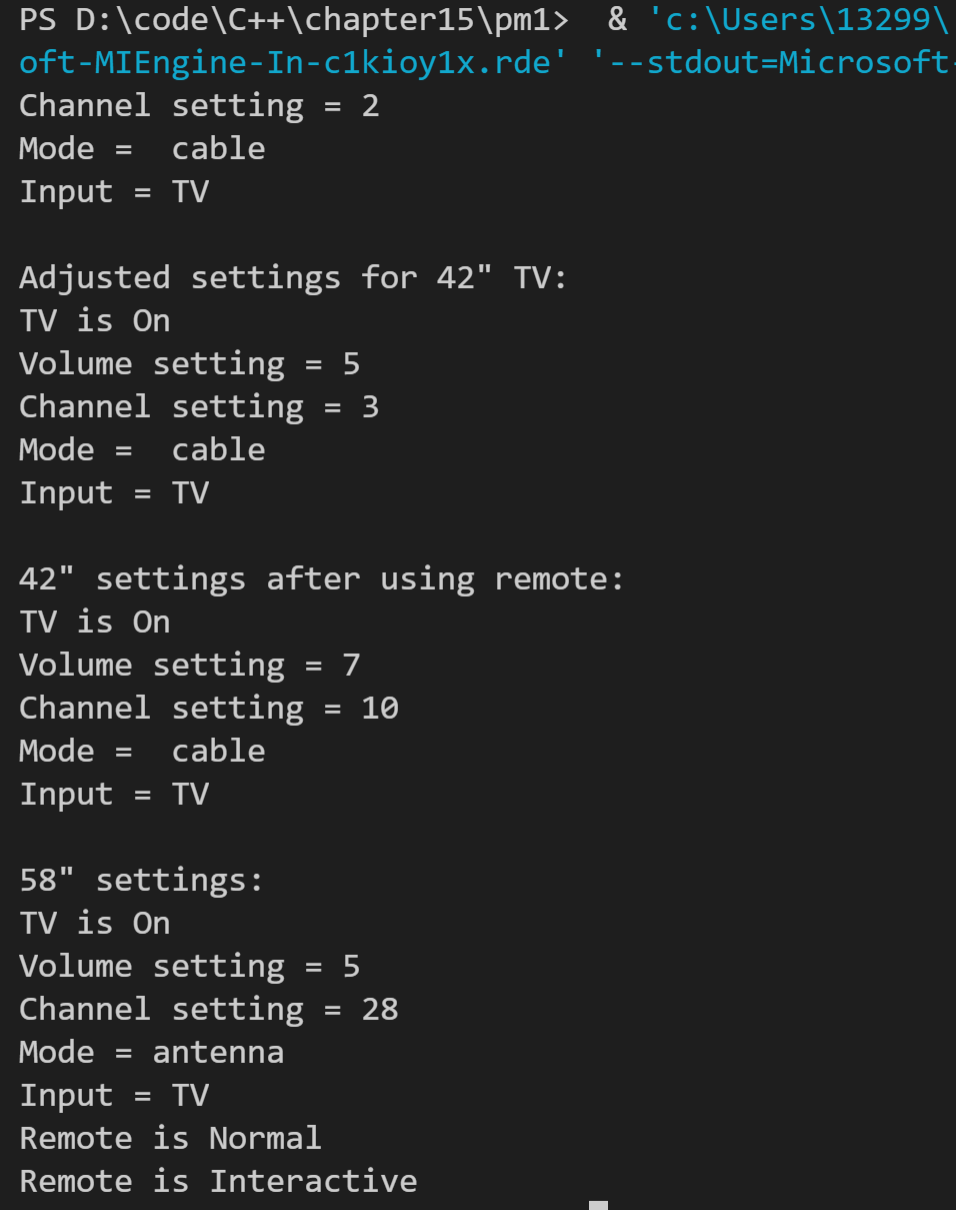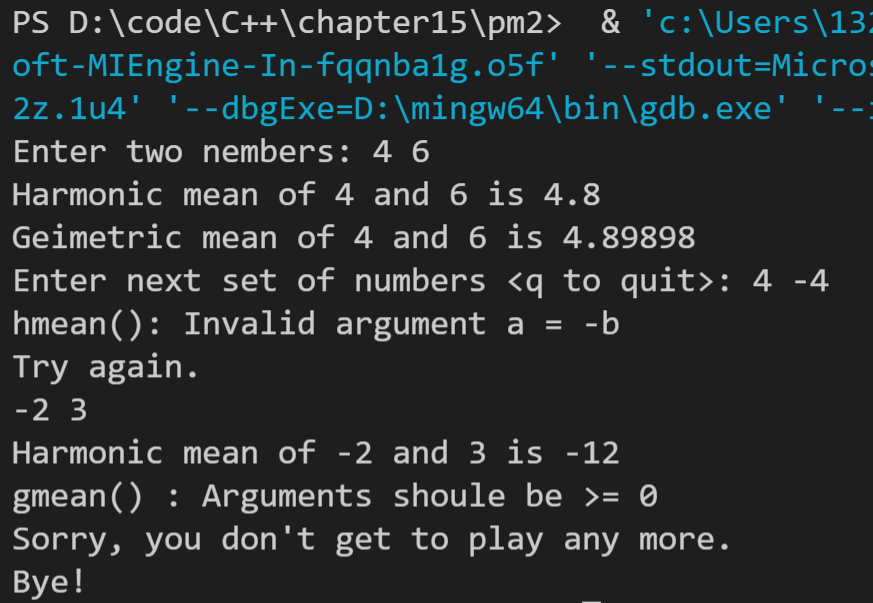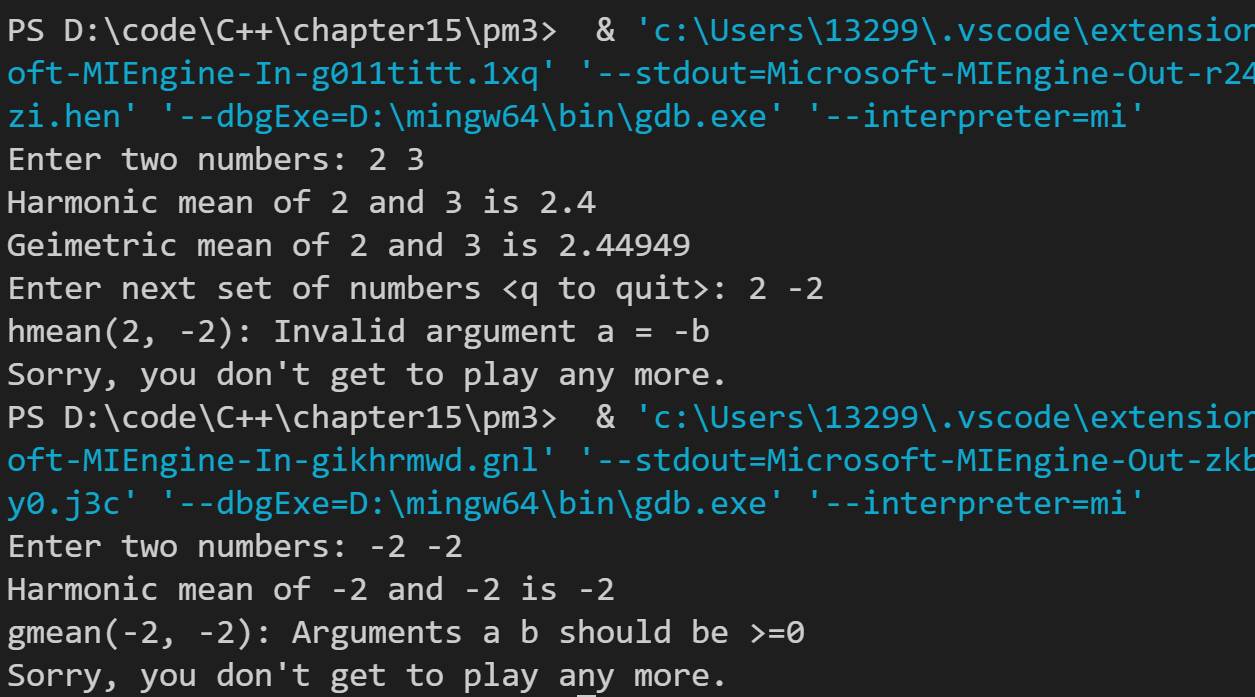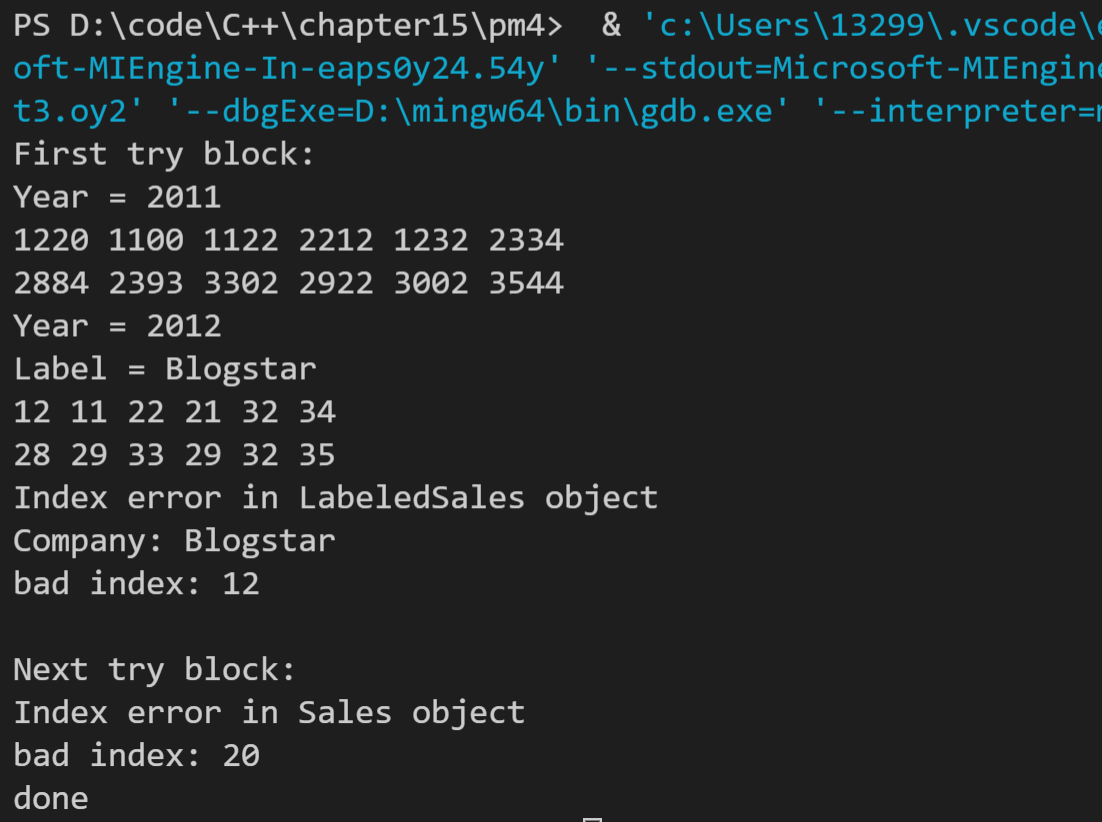C++ Primier Plus(第六版) 第十五章 友元、异常和其他 编程练习答案
1. 对Tv和Remote类做如下修改:
a. 让他们互相称为友元;
b. 在Remote类中添加一个状态变量成员,该成员描述遥控器是否处于常规模式还是互动模式;
c. 在Remote类中添加一个显式模式的方法
d. 在Tv类中添加一个对Remote中新成员进行切换的方法,该方法今在Tv处于打开状态时才能运行。编写一个小程序来测试这些新特性。
本题不算难,首先需要加一个前向声明在Tv class的声明之前,这样才可以将Remote声明为Tv的友元类,添加状态成员为私有,修改Remote的构造函数,添加一个显式模式的方法,在Tv中添加对Remote进行切换的方法,同时在Remoter中调用该函数,使遥控器可以切换是否为互动模式,这里实现时需要用到*this指针。代码如下:
// tv.h -- class definition for Tv class and Remote class
// friend class
#ifndef TV_H_
#define TV_H_
class Remote;
class Tv
{
private:
int state;
int channel;
int maxchannel;
int volume;
int mode;
int input;
public:
friend class Remote;
enum {Off, On};
enum {MaxChannel = 125};
enum {MinVol, MaxVol = 25};
enum {Antenna, Cable};
enum {TV, DVD};
Tv(int s = Off, int mc = MaxChannel) : state(s), channel(1),
maxchannel(mc), volume(5), mode(Cable), input(TV) { }
void onoff() { state = (state == On) ? Off : On;}
bool isOn() { return state == On; }
bool volup();
bool voldown();
void chanup();
void chandown();
void set_mode() { mode = (mode == Cable) ? Antenna : Cable; }
void set_input() { input = (input == TV) ? DVD : TV; }
void set_rmode(Remote & r); // set mode of Remote
void settings() const;
};
class Remote
{
private:
int mode; // control TV or DVD
int r_mode; // control Normal or Interactive
public:
friend class Tv;
enum {Normal, Interactive};
Remote(int m = Tv::TV, int rm =Normal) : mode(m), r_mode(rm) { }
void onoff(Tv & t) { t.onoff(); }
bool volup(Tv & t) { return t.volup(); }
bool voldown(Tv & t) { return t.voldown(); }
void chanup(Tv & t) { t.chanup(); }
void chandown(Tv & t) { t.chandown(); }
void setchannel(Tv & t, int chan) { t.channel = chan; }
void set_mode(Tv & t) { t.set_mode(); }
void set_input(Tv & t) { t.set_input(); }
void set_rmode(Tv & t);
void display_mode() const;
};
#endif
// tv.cpp -- methods for Tv class and Remote class
#include <iostream>
#include "tv.h"
bool Tv::volup()
{
if (volume < MaxVol)
{
volume++;
return true;
}
else
return false;
}
bool Tv::voldown()
{
if (volume > MinVol)
{
volume--;
return true;
}
else
return false;
}
void Tv::chanup()
{
if (channel < MaxVol)
channel++;
else
channel = 1;
}
void Tv::chandown()
{
if (channel > 1)
channel--;
else
channel = MaxChannel;
}
void Tv::set_rmode(Remote & r)
{
if (isOn())
r.r_mode = (r.r_mode == Remote::Normal) ?
Remote::Interactive : Remote::Normal;
}
void Tv::settings() const
{
using std::cout;
using std::endl;
cout << "TV is " << (state == Off ? "Off" : "On") << endl;
if (state == On)
{
cout << "Volume setting = " << volume << endl;
cout << "Channel setting = " << channel << endl;
cout << "Mode = "
<< (mode == Antenna ? "antenna" : " cable") << endl;
cout << "Input = "
<< (input == TV ? "TV" : "DVD") << endl;
}
}
void Remote::set_rmode(Tv & t)
{
t.set_rmode(* this);
}
void Remote::display_mode() const
{
using std::cout;
using std::endl;
cout << "Remote is " << (r_mode == Normal ? "Normal" : "Interactive") << endl;
}
// usetv.cpp -- test Tv and Remote class
// compile with tv.cpp
#include <iostream>
#include "tv.h"
int main()
{
using std::cout;
Tv s42;
cout << "Initial settings for 42\" TV:\n";
s42.settings();
s42.onoff();
s42.chanup();
cout << "\nAdjusted settings for 42\" TV:\n";
s42.settings();
s42.chanup();
cout << "\nAdjusted settings for 42\" TV:\n";
s42.settings();
Remote grey;
grey.setchannel(s42, 10);
grey.volup(s42);
grey.volup(s42);
cout << "\n42\" settings after using remote:\n";
s42.settings();
Tv s58(Tv::On);
s58.set_mode();
grey.setchannel(s58, 28);
cout << "\n58\" settings:\n";
s58.settings();
grey.display_mode();
grey.set_rmode(s58); // test set_rmode
grey.display_mode();
return 0;
}
运行结果如下:

2. 修改程序清单15.11,使两种异常类型都是从头文件stdexcept提供的logic_error类派生出来的类。让每个what方法都报告函数名和问题的性质。异常对象不需要存储错误的参数值,只需要提供what()方法。
本题考查的是logic_error派生类的定义,需要注意logic_error的构造函数需要一个字符串作为参数;定义好两个错误类之后,修改了程序清单15.11让错误指向logic_error的引用,统一输出信息what(),再根据可不可以转换成bad_hmean引用来决定终止还是继续尝试。代码如下:
// exc_mean.h -- class for exception of hmean and gmean
#ifndef EXC_MEAN_H_
#define EXC_MEAN_H_
#include <stdexcept>
#include <iostream>
#include <string>
class bad_hmean : public std::logic_error
{
public:
explicit bad_hmean(const std::string & s = "hmean(): Invalid argument a = -b")
: logic_error(s) { }
virtual const char * what();
virtual ~bad_hmean() { }
};
class bad_gmean : public std::logic_error
{
public:
explicit bad_gmean(const std::string & s = "gmean() : Arguments shoule be >= 0")
: logic_error(s) { }
virtual const char * what();
virtual ~bad_gmean() { }
};
#endif
inline const char * bad_hmean::what()
{
return logic_error::what();
}
inline const char * bad_gmean::what()
{
return logic_error::what();
}
// error4_15_11.cpp -- using exception classes
#include <iostream>
#include <cmath> // or math.h, unix users may need -lm flag
#include "exc_mean.h"
// function prototypes
double hmean(double a, double b);
double gmean(double a, double b);
int main()
{
using std::cout;
using std::cin;
using std::endl;
double x, y, z;
cout << "Enter two nembers: ";
while (cin >> x >> y)
{
try{
z = hmean(x, y);
cout << "Harmonic mean of " << x << " and " << y
<< " is " << z << endl;
z = gmean(x, y);
cout << "Geimetric mean of " << x << " and " << y
<< " is " << z << endl;
cout << "Enter next set of numbers <q to quit>: ";
}
catch (std::logic_error & le)
{
cout << le.what() << endl;
try
{
le = dynamic_cast<bad_hmean &> (le);
}
catch(const std::bad_cast& bc)
{
cout << "Sorry, you don't get to play any more.\n";
break;
}
cout << "Try again.\n";
continue;
}
}
cout << "Bye!\n";
return 0;
}
double hmean(double a, double b)
{
if (a == -b)
throw bad_hmean();
else
return 2 * a * b / (a + b);
}
double gmean(double a, double b)
{
if (a < 0 || b < 0)
throw bad_gmean();
else
return sqrt(a * b);
}
运行结果如下:

3. 这个练习与编程练习而相同,但异常类是从一个这样的基类派生而来:它是从logic_error派生而来,并存储两个参数值。异常类应该有一个这样的方法:报告这些值及函数名。程序使用一个catch块来捕获基类异常,其中任何一种从该基类派生来的异常都将导致循环结束。
本题有不算难,与第二题类似,首先从logic_error派生出一个抽象类bad_meanABC,然后从该类派生出两个分别处理hmean()和gmean()的类,主函数修改catch部分即可。代码如下:
// exc_mean.h -- definition of exception of hmean() and gmean()
#ifndef EXC_MEAN_H_
#define EXC_MEAN_H_
#include <string>
#include <stdexcept>
#include <iostream>
class bad_meanABC : public std::logic_error
{
private:
double a_;
double b_;
public:
bad_meanABC(double a = 0, double b = 0, const std::string & s = "function name")
: logic_error(s), a_(a), b_(b) { }
double a_val() const { return a_; }
double b_val() const { return b_; }
virtual ~bad_meanABC() { }
virtual void mesg() const = 0;
};
class bad_hmean : public bad_meanABC
{
public:
bad_hmean(double a = 0, double b = 0, const std::string & s = "hmean") :
bad_meanABC(a,b, s) { }
~ bad_hmean() { }
virtual void mesg() const;
};
class bad_gmean : public bad_meanABC
{
public:
bad_gmean(double a = 0, double b = 0, const std::string & s = "gmean") :
bad_meanABC(a,b, s) { }
~ bad_gmean() { }
virtual void mesg() const;
};
#endif
inline void bad_hmean::mesg() const
{
std::cout << logic_error::what()
<< "(" << a_val() << ", " << b_val() << "): ";
std::cout << "Invalid argument a = -b \n";
}
inline void bad_gmean::mesg() const
{
std::cout << logic_error::what()
<< "(" << a_val() << ", " << b_val() << "): ";
std::cout << "Arguments a b should be >=0\n";
}
// pe3.cpp -- inheritance logic_error
#include "exc_mean.h"
#include <cmath>
double hmean(double a, double b);
double gmean(double a, double b);
int main()
{
using std::cin;
using std::cout;
using std::endl;
double x, y, z;
cout << "Enter two numbers: ";
while (cin >> x >> y)
{
try
{
z = hmean(x, y);
cout << "Harmonic mean of " << x << " and "
<< y << " is " << z << endl;
z = gmean(x, y);
cout << "Geimetric mean of " << x << " and "
<< y << " is " << z << endl;
cout << "Enter next set of numbers <q to quit>: ";
}
catch(const bad_meanABC & bm)
{
bm.mesg();
cout << "Sorry, you don't get to play any more.\n";
break;
}
}
return 0;
}
double hmean(double a, double b)
{
if (a == -b)
throw bad_hmean(a,b);
else
return 2 * a * b / (a + b);
}
double gmean(double a, double b)
{
if (a < 0 || b < 0)
throw bad_gmean(a,b);
else
return sqrt(a * b);
}
运行结果如下:

4. 程序清单15.16在每个try后面都使用两个catch块,以确保nbad_index异常导致方法label_val()被调用。请修改该程序,在每个try块后面都只使用一个catch块,并使用RTTI来确保适时调用调用label_val()。
本题不算难,但比较恶心。首先是异常类是嵌套类,该开始没有找到合适的基类来将两个类都引用,后来找到了logic_error类,又发现使用dynamic_cast存在问题,原因是使用了bad进行转换,以前使用目标类型的引用可以转换,是因为异常类不是嵌套类,这里两个不同的异常类又属于不同的嵌套类成员,因此需要首先声明一个转换后类型的变量,例如对于LabeledSales::nbad_index,这里应该声明地址,声明引用的需要赋初始值,而且地址比引用更适合使用dynamic_cast转换。代码如下:
// sales.h -- exceptions and inheritance
#include <stdexcept>
#include <string>
#ifndef SALES_H_
#define SALES_H_
class Sales
{
protected:
enum {MONTHS = 12};
public:
class bad_index : public std::logic_error
{
private:
int bi; // bad index value
public:
explicit bad_index(int ix,
const std::string & s = "Index error in Sales object\n");
int bi_val() const { return bi; }
virtual ~bad_index() throw() { }
};
explicit Sales(int yy = 0);
Sales(int yy, const double * gr, int n);
virtual ~Sales() { }
int Year() const { return year; }
virtual double operator[](int i) const;
virtual double & operator[](int i);
private:
double gross[MONTHS];
int year;
};
class LabeledSales : public Sales
{
public:
class nbad_index : public Sales::bad_index
{
private:
std::string lbl;
public:
nbad_index(const std::string & lb, int ix,
const std::string & s = "Index error in LabeledSales object\n");
const std::string & label_val() const { return lbl; }
virtual ~nbad_index() throw() {}
};
explicit LabeledSales(const std::string & lb = "none", int yy = 0);
LabeledSales(const std::string &lb, int yy, const double * gr, int n);
virtual ~LabeledSales() { }
const std::string & Label() const { return label; }
virtual double operator[](int i) const;
virtual double & operator[](int i);
private:
std::string label;
};
#endif
// sales.cpp -- Sales implementation
#include "sales.h"
using std::string;
Sales::bad_index::bad_index(int ix, const string & s)
: std::logic_error(s), bi(ix) { }
Sales::Sales(int yy)
{
year = yy;
for (int i = 0; i < MONTHS; i++)
gross[i] = 0;
}
Sales::Sales(int yy, const double * gr, int n)
{
year = yy;
int lim = (n < MONTHS) ? n : MONTHS;
int i;
for (i = 0; i < lim; i++)
gross[i] = gr[i];
for (; i < MONTHS; i++)
gross[i] = 0;
}
double Sales::operator[](int i) const
{
if (i < 0 || i >= MONTHS)
throw bad_index(i);
return gross[i];
}
double & Sales::operator[](int i)
{
if (i < 0 || i >= MONTHS)
throw bad_index(i);
return gross[i];
}
LabeledSales::nbad_index::nbad_index(const std::string & lb, int ix,
const std::string & s) : Sales::bad_index(ix, s)
{
lbl = lb;
}
LabeledSales::LabeledSales(const std::string & lb, int yy) : Sales(yy)
{
label = lb;
}
LabeledSales::LabeledSales(const std::string &lb,
int yy, const double * gr, int n) : Sales(yy, gr, n)
{
label =lb;
}
double LabeledSales::operator[](int i) const
{
if (i < 0 || i >= MONTHS)
throw nbad_index(Label(), i);
return Sales::operator[](i);
}
double & LabeledSales::operator[](int i)
{
if (i < 0 || i >= MONTHS)
throw nbad_index(Label(), i);
return Sales::operator[](i);
}
// use_sales15_16.cpp -- nested excpetions
#include <iostream>
#include "sales.h"
int main()
{
using std::cout;
using std::cin;
using std::endl;
double vals1[12] =
{
1220, 1100, 1122, 2212, 1232, 2334,
2884, 2393, 3302, 2922, 3002, 3544
};
double vals2[12] =
{
12, 11, 22, 21, 32, 34,
28, 29, 33, 29, 32, 35
};
Sales sales1(2011, vals1, 12);
LabeledSales sales2("Blogstar", 2012, vals2, 12);
cout << "First try block:\n";
try
{
int i;
cout << "Year = " << sales1.Year() << endl;
for (i = 0; i < 12; i++)
{
cout << sales1[i] << ' ';
if (i % 6 == 5)
cout << endl;
}
cout << "Year = " << sales2.Year() << endl;
cout << "Label = " << sales2.Label() << endl;
for (i = 0; i <= 12; ++i)
{
cout << sales2[i] << ' ';
if (i % 6 == 5)
cout << endl;
}
cout << "End of try block 1.\n";
}
catch(std::logic_error & le)
{
cout << le.what();
try{
LabeledSales::nbad_index & bad = dynamic_cast<LabeledSales::nbad_index &>(le);
cout << "Company: " << bad.label_val() << endl;
cout << "bad index: " << bad.bi_val() << endl;
}
catch(std::bad_cast)
{
Sales::bad_index & bad = dynamic_cast<Sales::bad_index &>(le);
cout << "bad index: " << bad.bi_val() << endl;
}
}
cout << "\nNext try block:\n";
try
{
sales2[2] = 37.5;
sales1[20] = 23345;
cout << "End of try block 2.\n";
}
catch(std::logic_error & le)
{
cout << le.what();
try{
LabeledSales::nbad_index & bad = dynamic_cast<LabeledSales::nbad_index &>(le);
cout << "Company: " << bad.label_val() << endl;
cout << "bad index: " << bad.bi_val() << endl;
}
catch(std::bad_cast)
{
Sales::bad_index & bad = dynamic_cast<Sales::bad_index &>(le);
cout << "bad index: " << bad.bi_val() << endl;
}
}
return 0;
}
使用引用的动态转换代码与使用地址的代码只有主函数不同,就编程而言,可以使用地址动态转换时尽量使用地址,使用引用的代码如下:
// use_sales15_16.cpp -- nested excpetions
#include <iostream>
#include "sales.h"
int main()
{
using std::cout;
using std::cin;
using std::endl;
double vals1[12] =
{
1220, 1100, 1122, 2212, 1232, 2334,
2884, 2393, 3302, 2922, 3002, 3544
};
double vals2[12] =
{
12, 11, 22, 21, 32, 34,
28, 29, 33, 29, 32, 35
};
Sales sales1(2011, vals1, 12);
LabeledSales sales2("Blogstar", 2012, vals2, 12);
cout << "First try block:\n";
try
{
int i;
cout << "Year = " << sales1.Year() << endl;
for (i = 0; i < 12; i++)
{
cout << sales1[i] << ' ';
if (i % 6 == 5)
cout << endl;
}
cout << "Year = " << sales2.Year() << endl;
cout << "Label = " << sales2.Label() << endl;
for (i = 0; i <= 12; ++i)
{
cout << sales2[i] << ' ';
if (i % 6 == 5)
cout << endl;
}
cout << "End of try block 1.\n";
}
catch(std::logic_error & le)
{
cout << le.what();
try{
LabeledSales::nbad_index & bad = dynamic_cast<LabeledSales::nbad_index &>(le);
cout << "Company: " << bad.label_val() << endl;
cout << "bad index: " << bad.bi_val() << endl;
}
catch(std::bad_cast)
{
Sales::bad_index & bad = dynamic_cast<Sales::bad_index &>(le);
cout << "bad index: " << bad.bi_val() << endl;
}
}
cout << "\nNext try block:\n";
try
{
sales2[2] = 37.5;
sales1[20] = 23345;
cout << "End of try block 2.\n";
}
catch(std::logic_error & le)
{
cout << le.what();
try{
LabeledSales::nbad_index & bad = dynamic_cast<LabeledSales::nbad_index &>(le);
cout << "Company: " << bad.label_val() << endl;
cout << "bad index: " << bad.bi_val() << endl;
}
catch(std::bad_cast)
{
Sales::bad_index & bad = dynamic_cast<Sales::bad_index &>(le);
cout << "bad index: " << bad.bi_val() << endl;
}
}
return 0;
}
运行结果如下:



